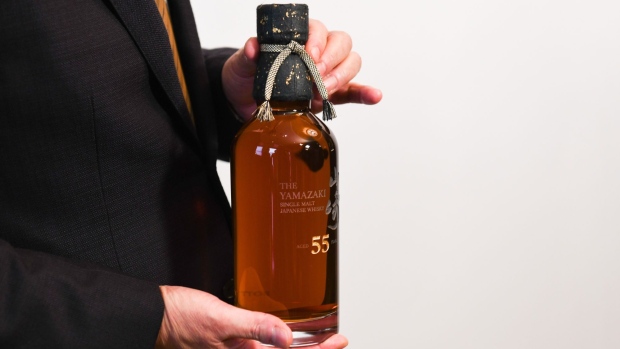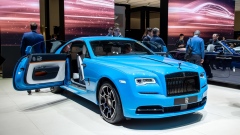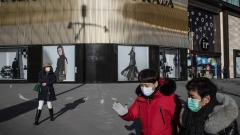Feb 18, 2021
What the new Japanese whisky regulations mean for collectors
, Bloomberg News
Whisky Is Fast Becoming 'Liquid Gold', Rare Finds Worldwide Says
What is Japanese whisky?
Despite its meteoric rise on the global connoisseur market, until this week that question was more complicated to answer than you might suspect. Unlike bourbon and Scotch—born of the U.S. and Scotland, respectively—the preferred brown spirit of Japan carried no actual denomination of origin. As long as the liquor was bottled within the country, it could be sourced from anywhere on the planet.
“To say that whisky-making regulations in Japan are loose is a major understatement,” Stefan van Eycken, author of Whisky Rising: The Definitive Guide to the Finest Whiskies and Distillers of Japan, told Bloomberg in 2019. “If they were any looser, you’d be able to sell tap water as Japanese whisky.”
That practice will soon change thanks to new labeling standards established on Feb. 12 by the Japan Spirits & Liqueurs Makers Association (JSLMA), a nongovernmental trade group of the country’s major producers. For the first time, consumers are going to have a clear concept of what Japanese whisky actually is: whisky actually made in Japan.
The internal regulations take affect on April 1 for new products, although for bottles currently in production and on sale, producers have until March 31, 2024, to comply with the edict. The Japanese government is expected to officially adopt the regulations as well, which once locked into law, will subsequently affect trade agreements worldwide. (In the U.S., for instance, the Tax and Trade Bureau already defers to guidelines for the official governmental parameters of Canadian, Irish, and Scotch whiskeys. So importers of their Japanese counterpart will no longer be able to bring in products that don’t meet the agreed-upon requirements.)
Its impact is already reverberating across the whiskey world. Nikka, the country’s second-largest whisky maker, announced on its website that it will immediately begin distinguishing between bottlings that do and do not satisfy the new criteria.
“Certain Nikka products don’t meet the requirements of ‘Japanese whisky,’ as some blends contain whiskies from outside Japan, most notably Scotland,” says a spokesperson for the brand. “Nikka’s priority is creating distinguished and consistent taste profiles, which is likely why they’re deciding not to alter the liquid to fit the new standards.”
Those liquids include Nikka Days—lighter and grain-forward, with slightly peated edges, released last year—and Nikka Whisky From the Barrel. This latter example is more likely to rankle connoisseurs and high-end collectors. The robust blend, recognizable by its squatty, rectangular bottle, has been a Tokyo barroom staple since the mid-1980s. It didn’t arrive in the U.S. until 2018, however, and was almost instantly honored as that year’s best whisky, according to Whisky Advocate magazine. The accolade made it harder to find and increased its standing on the secondary market, where it can list for $200, about three times its suggested retail value of US$65.
“I had no idea it contained whisky from outside of Japan,” admits Shawn Kim, owner of 58 Wines in Midtown Manhattan. “I was able to get 10 cases at a time before it got popular. I hate whenever something I love is named ‘whisky of the year,’ because then people start treating it like a trophy, and they stop actually drinking it.”

In fact, many Japanese whiskies are given the trophy treatment these days—especially age-statement single malts and blends from the country’s top producer: Suntory. The producer held a lottery a year ago for the privilege of spending US$27,600 on a single bottle.
Hideki Kanda, chairman of the JSLMA, also serves as the president of Suntory Spirits. A spokesperson for the brand confirmed that all its labels sold in the U.S.—including Hakashu, Hibiki, Toki, and Yamazaki—conform to the new standards. Expect demand for these bottles to climb higher still as its noncompliant counterparts with age statements are plucked from shelves. (Not only will these outliers be forced to remove the word “Japanese” from their label, but they’ll also have to excise all references to the country, its culture, and language—that is, no circle of the sun flags or kanji script.)
Japanese whisky emerged as an international sensation almost 10 years ago, so why did it take so long for these labeling guidelines to emerge? As with the mystique of rustic, salt o’ the Earth marketing in the bourbon industry—Diaego’s Bulleit being a prime early example—several nondistilling opportunists have cropped up, each with the potential to diminish the overall integrity of the category.
“In Japan, nobody is really misled by any of this,” says Eli Raffeld, who lived in the country before moving back to the U.S. in 2012 to start an import-export company for craft beer. In 2019 he started High Road Spirits LLC, the primary importer for family-owned Japanese distilleries including Akkeshi, Chichibu, Eigashima, Kanosuke, and Mars Shinshu.
“It’s common practice,” in Japan, he says, to be bottling and settling whiskies that include a component imported from another country, “almost to the point of tradition. So people don’t really think about it.”

Logistically, this is because the country doesn’t possess a ton of grain distilleries to produce the lighter, filler liquid that makes up the majority of the volume of a blend. A whisky’s robustness and weight comes from the malt, which often is produced domestically.
Philosophically, the notion of provenance is actually a secondary consideration in this part of the world. Blending is the true art. It’s why Japanese whisky houses are more likely to champion master blenders than distillers on marketing material. And it’s also why Nikka is confident about preserving the precise blend of Whiskey From the Barrel, even if it means shedding the words “Japanese whisky” from its moniker.
“We do not make superior or inferior distinctions of flavor based on geographical indications,” says Emiko Kaji, international business development manager for Nikka. “If using imported whiskies as a part of the formula is beneficial to create or maintain the flavors of our unique expressions, we will continue this practice.”
Raffeld, for his part, is entirely supportive of this notion. “It’s just a matter of knowing what you’re getting,” he says. “If I had spent a lot of my own money on a teak wood dining room table and then discovered it was pine, I might feel a little different about it.”
His company is the U.S. importer of Chichibu whisky. Over the past decade, its founder, Ichiro Akuto, has been an unwavering advocate for transparency in the industry. He even coined the term “world whisky” to describe a blended house malt with imported grain components; the highly coveted Malt & Grain makes use of spirits from Canada, Ireland, Japan, Scotland, and the U.S.
“Ultimately it comes down to taste, price, and consumer preference,” Raffeld says. “Do they really enjoy it enough to spend that amount of money on it? They’ll either succeed or fail at that moment. We’re excited to see what happens.” And fans of Japanese whisky will be excited to know, once and for all, precisely what’s in their glass.


